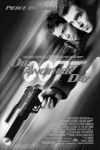 |
| |
MI6 looks back to 2002 and the American Cinematographer report on James Bond's experimentation with computer graphics...
|
|
007 Takes the CGI Plunge
20th March 2010
By Ron Magid, from the November 2002 issue of American Cinematographer
Visual-effects supervisor Mara Bryan has helped make James Bond's heroics believable since Pierce Brosnan took over the role on Goldeneye. On that film, Bryan assisted legendary Bond effects guru Derek Meddings on his final foray, marrying his old-school approach with digital technology. She moved up to visual-effects producer on Tomorrow Never Dies and became a supervisor on The World is Not Enough. For Die Another Day, she had to devise the most ambitious effects yet for the longest-running series in cinema history.
"Die Another Day has three times the number of effects shots and three times the complexity of anything we did last time," Bryan observes. "[Director] Lee Tamahori has been very adventurous, and the film has a lot of effects sequences that just couldn't have been done without digital technology -- courtesy of Cinesite, the Moving Picture Company, CFC Frame Store, and Double Negative -- and model work by [longtime Bond effects artist] John Richardson."
Right: Director Lee Tamahori |
|
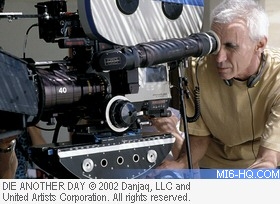
|
With its spectacular locations and fanciful environments, Die Another Day feels like a throwback to the early Bond films, in which effects helped to create giant military bases inside active volcanoes and the like. Bryan supervised a number of units shooting blue-screen work, which at times included the main and second units.
More than 50 effects shots were needed to create a spectacular sequence in which Bond nemesis Col. Moon uses a deadly beam of sunlight to send 007's jet-powered ice yacht -- and the cliff it's sailing on -- plunging into the icy sea below. Thinking quickly, 007 grabs a parachute as he sails toward the raging waters, where the impact of the falling glaciers creates a mega-tsunami. "And then, of course, he appears to be almost kite-surfing on an enormous, 150-foot-high wave as the [Bond theme] swells," Bryan says with a chuckle.
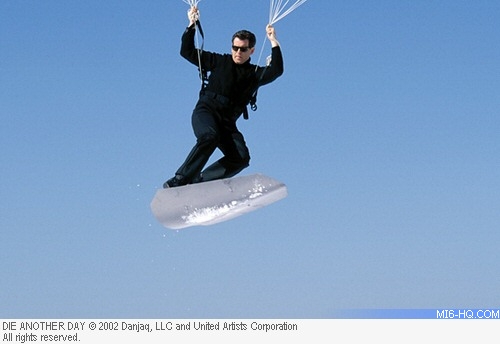
Above: 007 lands after a daring feat of glacial wave surfing.
|
Bryan says it took every trick in the book to make Bond's icy plunge and gale-force parasailing look credible. "It's a very short sequence but probably the most demanding one in the film," she says. "We shot Pierce against blue-screen, and everything else was entirely CG. Ice has a translucency and a transparency that we can't actually give to a CG object, so we had to simulate it with lighting and shaders. When Lee Tamahori asked me whether we could do it, I just looked at him and said, 'Er ... yeah,' and then I went to Cinesite and said, 'I've just said yes, so we've got to do this!"'
Bryan began by gathering reference materials in Iceland and other frosty locales. "I went to Spitsbergen, up near the Arctic Circle, to shoot reference plates and large-format stills that we could use to digitally texture the ice," she recalls. "I obtained every book on Antarctica that was ever printed, and the art department supplied a lot of reference material."
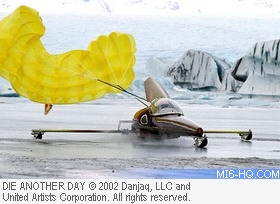
Above: The sequence begins with Graves' space-laser persuing 007 in the ice-bound dragster.
|
|
According to Dottie Starling, supervisor of Cinesite's wave-sequence work, it took about a year of R&D and testing to perfect software for the water shots (a combination of Cinesite's proprietary water-generation and particle-rendering programs, along with Maya and Houdini), and it took six months to perfect the iceberg shader and water-interaction software (Renderman and beta testing of Renderman II). "Getting the general movement of the water right and the proper scale for how big the wave should be was a challenge, and because it was ice and water we also had to create reflection and refraction," Starling explains. "The amount of detail involved in a shot of that scale was considerable. |
"Refraction was mainly achieved by testing and using Pixar's new Renderman II, and by using our in-house shader writer, Douglas Harsch, to set up very specific controls and pipelines to ensure the software was working," she continues. "One of our head TDs, Matthew Maude, wrote some custom Maya plug-ins to give some red light transmission through the iceberg geometry, which was then read into shaders. All reflections were achieved through ray tracing and in-house shaders developed specifically for this project."
The Cinesite team was a bit surprised to discover how hard it was to make it look as though the icebergs were interacting with the water. "It was difficult to get the scale and movement between the two elements to work in a naturalistic way," Starling says.
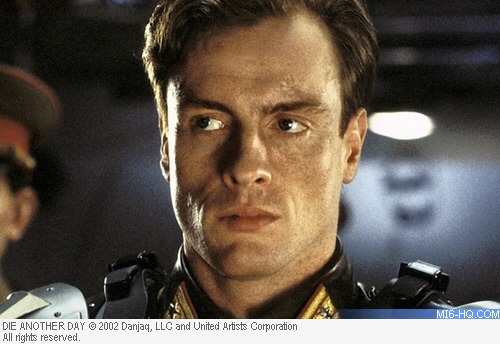
Above: Graves, who controls the Icarus satellite from a space-age body suit.
|
"Lee Tamahori didn't play by any of the Bond rules," Bryan says in conclusion. "Die Another Day has broken the mold, and it was exciting to do something no one had done before. This is the first Bond film to feature cutting-edge digital effects, and what everyone managed to achieve is pretty spectacular."

With permission from American Cinematographer magazine www.theasc.com www.cinematographer.com is no longer the official site of the American Society of Cinematographer or American Cinematographer magazine.
|
Related Articles
 Die Another Day
Die Another Day
 James Bond 101 - Article Archive
James Bond 101 - Article Archive